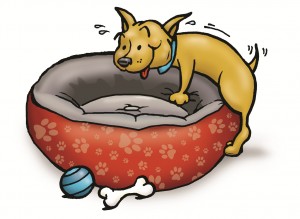Michael Baugh CPDT-KSA, CDBC
The funny thing is, life never seems to turn out exactly as planned. For example, I didn’t really plan on fostering a dog. Tim and I haven’t had much success with it in the past, and frankly I didn’t think he’d go for the idea. As it turns out, Buddy was available as a short-term “holiday foster” and Tim said yes.
My guess is that Buddy’s life isn’t going exactly as he’d planned either (if in fact dogs do any planning at all). The folks from Corridor Rescue Inc. found him in a parking lot, homeless and without a human. He had heartworms (light positive) and probably hadn’t had a good meal in a while. He settled in nicely at a local kennel until the holidays rolled around. The kennel needed his run for the holiday rush, so Buddy came to us. Now, here he is by my side gnawing a bully stick (video) as I write.

I really didn’t expect Buddy to be so amazingly and beautifully – average. Certainly he has the magic and wonder that all average dogs have. It’s not an insult. It’s just that most of the dogs I see day in and day out have problems adjusting to and coping with life with humans. Some have serious problems. Buddy, despite his questionable beginnings, doesn’t. Despite having no place beyond his modest run to call home, despite having nothing – not so much as a collar, Buddy is undamaged – average – just a typical dog – just Buddy.
He renews my faith in life and all its plans gone awry. He hadn’t been in our home an hour before he was playing. It was vigorous and joyful. It wasn’t play for the weary; it was play for the living, for those filled with life. He dodged and chased and hip-checked Stella like he’d known her forever. She tired of it long before he did (and let him know it). Given the chance, he’d have played on. I’m sure of it.
I’d planned on training Buddy. It was my plan to send him back better than I’d found him. It’s clear that there isn’t a hand signal or a verbal cue that registers familiar in his happy little brain. It’s also clear that he’s learned a whole lot about what it takes to survive in our crazy human world without any help from me. Here’s what he’s shown me so far.
- Car rides are for sleeping. When the car stops, wake up and begin the next adventure.
- Leashes are more comfortable when not pulling. Sniff along the way but not for too long. Avoid garbage bags.
- Crying in the crate might work (not at our house). If it fails, sleep in crate instead.
- My name is Buddy.
- People are safe. Go to them when they call my name.
- Chase the ball; bring it back.
- Dogs equal play. If a dog doesn’t want to play, keep trying.
Of course, that last one doesn’t always go as planned. A couple of dogs can be great fun. Too many dogs at once can be scary. Buddy didn’t do too well in his first try at dog daycare. He was tense, and sometimes a bit too intense. He didn’t make friends easily or quickly; he didn’t made friends at all really. The stress built; he lashed out; then he got kicked out of the group.
Life is unpredictable, but you can count on one thing. It usually leads us where we need to go. Buddy needed a place to lay his head for the holidays. As for me, I guess I needed a Buddy – a guy who is sometimes a bit rough around the edges with social scenes, a guy who’s learned a lot about life but never tires of learning more.
Buddy is available for adoption immediately. He is appropriate for a household with other dogs who enjoy athletic play, and he is reportedly cat familiar. He’s an excellent training candidate. My dog training services come with him (Houston Metro Only).


